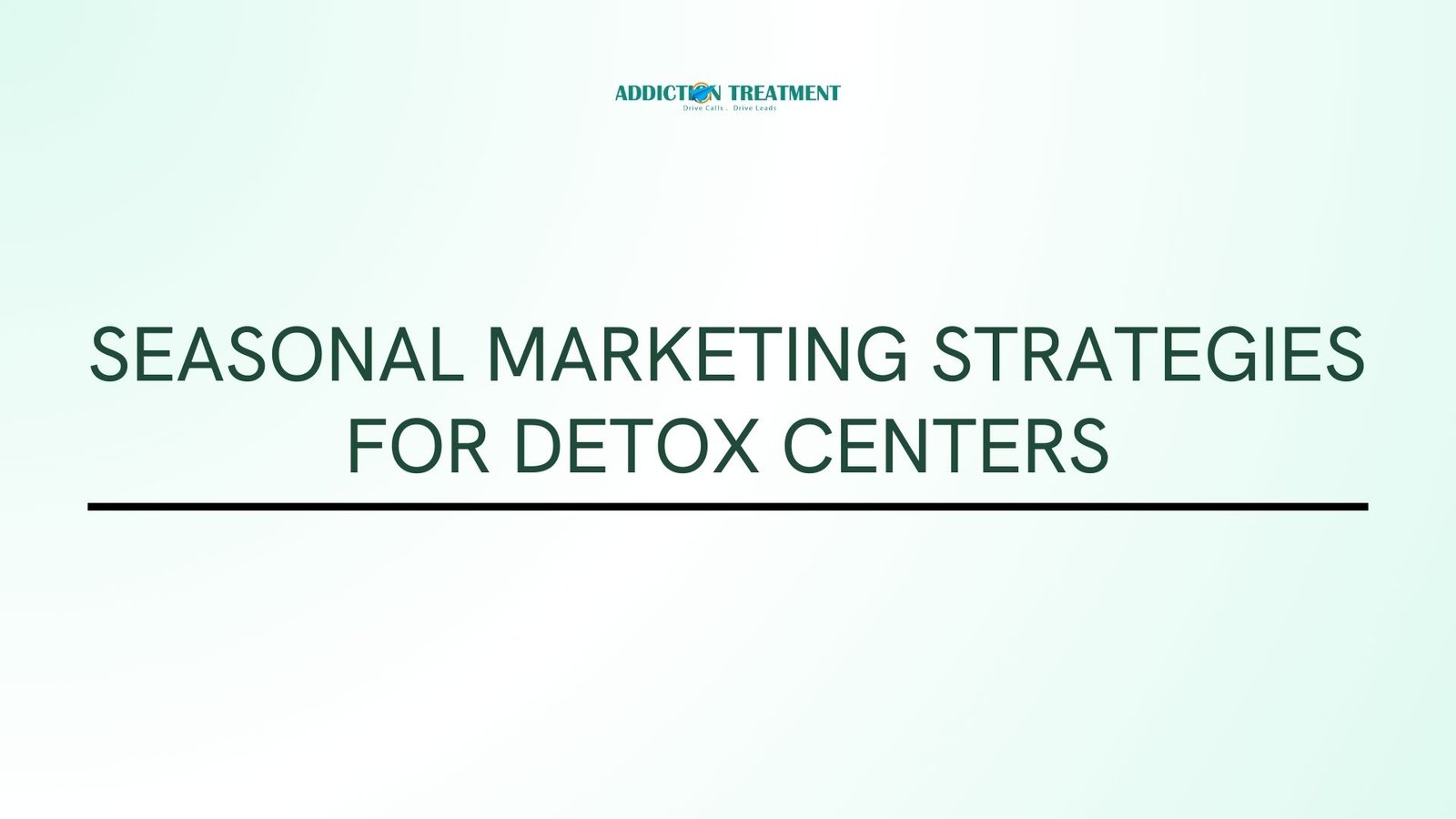The demand for detox centers often fluctuates throughout the year due to factors like holidays, New Year’s resolutions, or seasonal stressors. To capitalize on these trends, detox centers must adopt seasonal marketing strategies that resonate with their target audience and address the unique challenges of each season. By tailoring campaigns to align with specific times of the year, detox centers can drive more inquiries, increase admissions, and build long-term connections with individuals seeking help.
Why Seasonal Marketing Matters for Detox Centers
Seasonal marketing leverages the natural ebb and flow of consumer behavior, helping detox centers connect with individuals when they are most likely to seek assistance. Key benefits include:
- Enhanced Relevance: Seasonal campaigns are more likely to resonate with individuals experiencing time-specific challenges, such as holiday stress or post-summer recovery.
- Increased Engagement: Tailored content and offers can capture the attention of your audience during key periods.
- Better Resource Allocation: Understanding seasonal trends allows detox centers to optimize their marketing budget and staffing during peak times.
Seasonal Trends in Detox Center Admissions
Before implementing seasonal strategies, it’s essential to understand the patterns that influence demand:
- New Year’s Resolutions (January): Many individuals commit to sobriety at the start of the year, making January a peak month for admissions.
- Post-Holiday Recovery (January-February): The aftermath of holiday indulgence often leads to increased interest in detox programs.
- Spring Renewal (March-May): The concept of “spring cleaning” extends to personal health, as individuals look to refresh and detoxify.
- Summer Prep (May-June): People may seek detox services to improve their health or appearance before summer vacations.
- Post-Summer (September): After summer festivities, individuals often seek help to reset and refocus.
- Year-End Stress (November-December): The holiday season can exacerbate stress and substance use, leading to increased interest in detox programs.
Seasonal Marketing Strategies for Detox Centers
1. Leverage New Year’s Resolutions
The start of the year is a prime time for promoting detox services. People are motivated to make positive changes, including overcoming substance dependency.
- Create Resolution-Themed Campaigns: Use messaging like “Start the Year Fresh: Join Our Detox Program” or “New Year, New You.”
- Offer Limited-Time Discounts: Provide incentives for early sign-ups in January.
- Publish Educational Content: Write blogs or create videos about the benefits of starting the year with a detox program.
2. Address Post-Holiday Recovery
The holiday season often leads to increased alcohol consumption and unhealthy habits, making January and February key months for detox inquiries.
- Target Holiday Stress: Use campaigns focusing on recovering from holiday stress and indulgence.
- Run Social Media Ads: Promote your detox services on platforms like Facebook and Instagram with relatable content about post-holiday health resets.
- Collaborate with Influencers: Partner with wellness influencers to share tips on recovery and detox after the holidays.
3. Promote Spring Renewal
Spring is associated with new beginnings, making it an ideal time to attract individuals looking to prioritize their health.
- Spring-Themed Messaging: Use slogans like “Refresh Your Body This Spring” or “A Fresh Start for a New Season.”
- Offer Seasonal Discounts: Provide promotional packages for spring detox programs.
- Host Wellness Webinars: Organize online events focused on detoxification and holistic health.
4. Prepare for Summer Health Goals
As people gear up for summer, detox programs can position themselves as a way to achieve physical and mental well-being.
- Focus on Wellness and Fitness: Highlight how detox programs can improve energy levels and overall health.
- Run PPC Campaigns: Target keywords like “summer detox” or “get healthy for summer.”
- Partner with Fitness Centers: Collaborate with local gyms or personal trainers to promote your detox services.
5. Target Post-Summer Resets
After a season of vacations and celebrations, many individuals seek to reset their health routines in September.
- Back-to-Routine Campaigns: Use messaging like “Get Back on Track After Summer” to resonate with your audience.
- Email Marketing: Send newsletters to past leads encouraging them to consider a detox program for a fresh start.
- Content Marketing: Publish blogs about resetting health goals after summer indulgences.
6. Focus on Holiday Stress Management
The holiday season can be emotionally and physically taxing, leading some individuals to turn to substances for relief. Detox centers can address this challenge with tailored campaigns.
- Empathetic Messaging: Use compassionate and understanding language to connect with individuals feeling overwhelmed.
- Holiday-Themed Content: Create articles or videos about managing holiday stress without relying on substances.
- Offer Free Resources: Provide downloadable guides or tools to help individuals cope with holiday stress.
Digital Marketing Tips for Seasonal Campaigns
1. Geotarget Your Ads
Use geotargeting to focus on areas where demand for detox services is high during specific seasons.
2. Leverage Social Proof
Share testimonials or success stories that align with seasonal themes, such as individuals who joined your program as part of a New Year’s resolution.
3. Use Retargeting
Deploy retargeting campaigns to re-engage individuals who visited your website but didn’t convert. Tailor these ads to the season’s themes and messaging.
Measuring the Success of Seasonal Campaigns
Track the performance of your seasonal marketing strategies with these metrics:
- Inquiries and Admissions: Monitor the number of leads and conversions during each campaign.
- Click-Through Rate (CTR): Evaluate the effectiveness of your ads in driving engagement.
- Cost Per Lead (CPL): Assess the efficiency of your marketing spend.
- Website Traffic: Measure the increase in traffic during seasonal campaigns.
Challenges of Seasonal Marketing and How to Overcome Them
1. Competition
During peak times like January, many detox centers ramp up their marketing efforts, increasing competition.
- Differentiate Your Services: Highlight unique aspects of your programs, such as holistic approaches, personalized care, or success rates.
2. Budget Allocation
Seasonal campaigns may require higher budgets, especially during competitive periods.
- Plan Ahead: Allocate your annual budget strategically to ensure sufficient funds for high-demand seasons.
3. Audience Fatigue
Repeated seasonal campaigns can lead to reduced engagement over time.
- Keep Content Fresh: Continuously update your messaging and creative assets to maintain interest.
Future Trends in Seasonal Marketing for Detox Centers
As consumer behaviors and technology evolve, detox centers can adopt new trends to enhance their seasonal strategies:
- AI-Powered Insights: Use AI to predict seasonal trends and optimize campaigns for maximum impact.
- Personalized Messaging: Leverage data to create hyper-targeted seasonal campaigns that resonate with individual preferences.
- Interactive Content: Incorporate quizzes, webinars, or live Q&A sessions into your seasonal marketing efforts.
Conclusion
Seasonal marketing is a powerful tool for detox centers to connect with individuals when they are most motivated to seek help. By understanding seasonal trends, tailoring campaigns to align with audience needs, and leveraging digital tools, detox centers can maximize their impact and drive meaningful results. With the right strategies in place, your center can become a trusted resource for individuals seeking a fresh start, no matter the time of year.


Leave a Reply